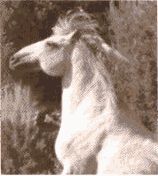|
(Information and graphics courtesy of BLM, Colorado District Office)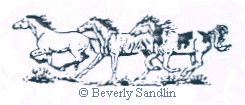
Did you know...The natural structure of a family of horses is the band. The dominant stallion is the boss. His role is to protect his band from danger and increase his harem of mares and foals. The band is led in its daily routine of grazing and watering by the lead mare. 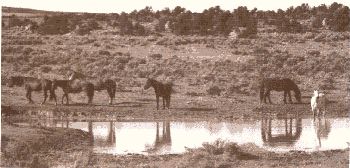
When searching for bands of wild horses, stud piles are the first sign of
horse activity. These large piles of manure are territorial markings left
by A mare may be left behind while giving birth. When the foal is able to travel, they will rejoin the band. The gestation period is usually 11 to 12 months. A good time to see foals is from April 1 to June 30. 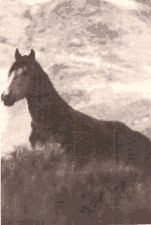
A young stallion, at the breeding age of two years or more, will be driven from his maternal band by the dominant stallion. The banished youngster will continue to follow the band at a distance until he finds other ousted young males to join up with. These groups are called "bachelor bands." You can observe these groups following family bands. Occasionally old studs will join a group of bachelors. 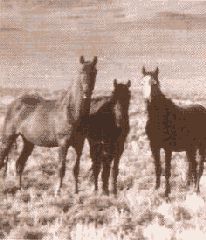
The lead mare is "second-in-command" to the dominant stallion in the band.
Cautiously she will lead the band of mares and foals to new forage areas and
watering holes. Ever watchful, she will take the lead for a fast retreat if
danger is present. The stallion will bring up the rear, ready to protect and
defend his band from any attack. A band of horses can be come easily
disoriented if the lead mare is lost or disoriented.
Ritual posturing and snorts often resolve a confrontation between stallions but fighting does occur. The males are at high risk from combat but death is unlikely. Horse pawing is used for communication, breaking ice in water holes, digging in deep snow for winter forage, and enlarging water holes. Continue OnThis is not a BLM operated or BLM sponsored site. It is run by private wild horse and burro enthusiasts. We are thankful to the BLM for providing the information which is presented here.
Return to "Wild Horses in Colorado" PageReturn to KBR World of Wild Horses & BurrosGo to other Wild Horse LinksGo To
|
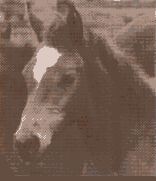 Wild horses are shy creatures and must be approached with caution. A wild
horse's natural instinct for defense is flight, but a stallion can show
aggression when he fears his family is being threatened. Enjoy viewing the
horses but do not attempt to chase or feed them.
Wild horses are shy creatures and must be approached with caution. A wild
horse's natural instinct for defense is flight, but a stallion can show
aggression when he fears his family is being threatened. Enjoy viewing the
horses but do not attempt to chase or feed them.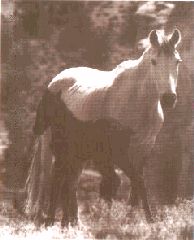 rival males. Recent horse activity is determined by the freshness of these
piles.
rival males. Recent horse activity is determined by the freshness of these
piles.